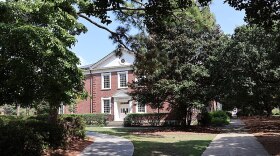Do you remember watching educational movies in elementary school? Older generations might think of the teacher setting up the 16 mm projector, while younger folks were assigned YouTube videos to watch at home.
Educational movies are part of a larger genre called nontheatrical film. These include movies shown in churches, museums, fairs, and other non-commercial settings. Nowadays, cellphone videos of police brutality, vlogs and student projects carry on the tradition of grassroots cinema. Without the pressure to entertain or rack up sales at the box office, nontheatrical filmmakers have critically examined race and American identity. Hollywood is only just starting to catch up.
While nontheatrical film vastly outnumbers Hollywood in output, there is little scholarly work assessing the materials. A new scholarly book takes a critical look at nontheatrical film and demonstrates that depictions of race in these materials are far more diverse than in mainstream cinema. Host Frank Stasio talks with editors and about the collection (Duke University Press/2019). Field is an associate professor and director of graduate studies at the University of Chicago and Marsha Gordon is a professor of film studies at North Carolina State University, a fellow at the National Humanities Center and a regular contributor to the Movies On The Radio series.
UPCOMING EVENTS:
Gordon will host a discussion and screening of some of the 16mm films at and at . All of the films in the book can be .
INTERVIEW HIGHLIGHTS:
Gordon on the category of nontheatrical film:
This is what I love about this category ŌĆö it's kind of a clunky idea, nontheatrical films, but it's a big umbrella under which so many things fall ŌĆ” [including] educational films, film [that] was made for church, films made for industry, but also things like home movies ŌĆ” And when we look at them now, as we do any historical artifact, we learn a lot about the past and especially on the subject of race, which was not really dealt with in theatrical contexts in a way that's frankly particularly interesting.
These small screens really helped balance the scales. - Allyson Nadia Field
Field on grassroots filmmakers portraying race:
I think what's so interesting is that the big screen [marginalized] people of color. These small screens really helped balance the scales. And this was a way for folks to take filmmaking into their own hands. So you have films made by, say, African American pastors in Oklahoma of their local communities and inviting people in to see themselves on screen, which is really a remarkable thing if we think about the 1920s and what films were doing coming out of something like ŌĆ£Birth of a NationŌĆØ and representation there. And then you have anthropologists going into communities and interested in the practices and artistic traditions of, say, First Nations people ŌĆ” When we get to the kind of post- civil rights movement, we find that 16 mm films were a way for teachers to engage with questions that were very much current in society.
Field on the 1974 film ŌĆ£Uhuru Ujimi Schule, Community Freedom SchoolŌĆØ:
Don Amis was a student at UCLA, and he was part of what has been called the LA rebellion of black filmmakers who came out of UCLA in the ŌĆś70s and ŌĆś80s ŌĆ” This [film] chronicles a day in the life of an afrocentric elementary school in South Central Los Angeles. And what's interesting about this film is that, because Don Amis was a member of the community ŌĆö dressed like them, spoke like them ŌĆö it gave him access to the children's world without the kind of self-consciousness that would have met an outsider. And it really shows in the film.
https://www.youtube.com/watch?v=3aZhn46ubWA
This is about history written from the bottom up, right? - Marsha Gordon
Gordon on nontheatrical film today:
Now we're talking about video and not film. People whip out their iPhones for all manner of reasons ŌĆö to document families, maybe it's to document somebody getting beaten by a police officer. There's a lot of different contexts where people are using their phones ŌĆö for frivolous and for unfrivolous reasons ŌĆö and then they upload that content. Well, that's not getting played in a movie theater. That's being generated by whoever has access to the means of recording it. And so, in some ways, this is about history written from the bottom up, right? ... As opposed to thinking about studios, which were white-owned, operated, and focused on profitability above all other things. There's a huge divide there, and I think we can still find that today. We just find it on the internet.











